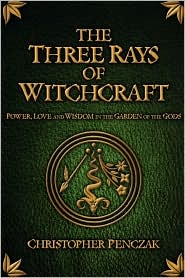
I've had the pleasure of reviewing Christopher Penczak's many books and tapes over the years, as well as the occasional direct correspondance. He is a prolific writer, deep thinker, and someone I feel is contributing the the strength of Witchcraft as a religion and a spiritual practice. He is also someone who goes places I just don't see as existing, and I am profoundly grateful that he does, and that he sends back missives to point the way for the rest of us. One of his gifts is to be a teacher, rendering difficult concepts into managable metaphors and harnessing disparate, seemingly contradictory ideas into graceful concepts.
The Three Rays of Witchcraft is unlike Penczak's other works, and this may put some readers off. For one thing, it is not an introductory guide. He presumes the reader has a solid, and deep, understanding of Witchcraft, magickal theory, and mythology. Another difference is that it isn't as polished as his other works. The Three Rays almost feels channeled, as if Penczak tapped into something external and just had to get it all down in bits and bytes. As a final difference, this is a fairly small book (perhaps his shortest!). If you equate size with impact, you'll miss out, because wrapped in this small package is a powerhouse of information.
Penczak writes:
Witches [often] see these powers as maiden, mother and crone. In Qabalistic magic, we have the three pillars of Mercy, Severity and Equilibrium. Druidic traditions look to three rays of inspiration, of Awen. Theosophists have the rays of Power, Love and Intelligence. . . . How can modern witches work with these three powers for magick, evolution and transformation? . . . The text outlines a model of the universe based upon the forces of Power, Love and Wisdom. Associated with each is a
path, a ray, that we can travel spiritually and evoke energetically. Known as the Straight Line, the Bent Line and the Crooked Line, each offers different opportunities of magick, knowledge and initiation.
I will admit right off that I struggled with this information. It *is* dense, and I'm not in an active learning frame of mind right now. I enjoyed getting to know how Penczak thinks, however, because he uses a lot of personal revelations to illustrate his writing. These stories were much more specific than he usually offers, perhaps because The Three Rays is very much the founding of a new Tradition. To be clear, I feel that my struggles were personal in nature, not the fault of poor or unclear writing. The Three Rays is absolutely the culmination of every single one of Penczak's prior books (all 16 of them) over a decade of intense writing.
The information presented is truly about the relationships between three branches of development as he sees it: divine, human, and devas. The information is conveyed clearly and succinctly, as usual for Penczak, the opposite of most occult writing, which tends towards obscurity and density. Penczak's desire is to weave together the disparate parts which have made their way into the modern Witchcraft movement, mostly through the Eclectic “anything goes” attitude among many practitioners who have collected bits and pieces from many spiritual backgrounds with no, or little attempt made to fit them into a workable model. Penczak's model shows how the various parts actually relate to one another.
The book offers:
Three Inner Cauldron Workings
Working with the Seven Wanderers
Blessing and Cursing
Triune Divinity of Divine Mind, Heart and Will
Protection Magick
Faery Contact
Paths of Initiation
Prosperity Magick
Communion with the Hidden Company
The Witch's Tonic
Angelic Contact
The Three Ray Cord
Vision of the Great Between
The Garden of the Gods Ritual
The Three Rays is the first publication from Penczak's new venture, Copper Cauldron Publishing, and I say the new venture is off to a brilliant start. While I don't recommend it for newcomers, long time practitioners will find a lot of food for thought and it should be on all of our shelves (and in our work rooms!). Highly recommended.
~review by Lisa Mc Sherry
Author: Christopher Penczak
Copper Cauldron Publishing, 2010
pp. 205, $19.99
